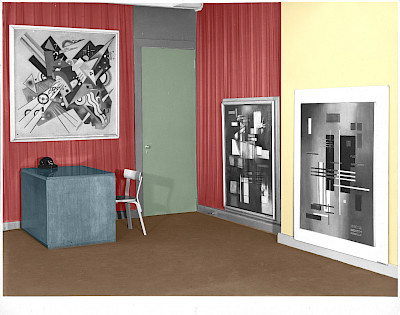m.n.o.p. / w.g.l.
The source images for the two series m.n.o.p. and w.g.l. are black-and-white installation photographs from two exhibitions held in New York and London in the 1940s and 1950s respectively. Thomas Ruff digitally colored particular areas of these with a color scheme reminiscent of the 1950s and subsequently enlarged them. While the works of art—out of respect for the artists and their works—remained untouched, he colored the carpets, the fabric-covered walls, and the ceilings. Through this processing, he underscores the exhibition aesthetic of the 1940s to the 1960s and, with the resulting abstract colored surface compositions, makes the viewer conscious of the designs of the exhibition organizers. All this emphasizes the contrast to the idea of the exhibition space as a “white cube,” which is widespread today. m.n.o.p. comprises installation views of the collection presentation of the Museum of Non-Objective Painting (now the Guggenheim Museum, New York) with works by Wassily Kandinsky, Rudolf Bauer, and other artists from the collection, which took place in 1948 in the first museum building on 24 East 54th Street. The motifs of w.g.l. originate from the exhibition Jackson Pollock 1912–1956, one of the most important exhibitions in terms of the mediation of contemporary art, which was presented at the Whitechapel Gallery in London in 1958.

m.n.o.p. / w.g.l.
The source images for the two series m.n.o.p. and w.g.l. are black-and-white installation photographs from two exhibitions held in New York and London in the 1940s and 1950s respectively. Thomas Ruff digitally colored particular areas of these with a color scheme reminiscent of the 1950s and subsequently enlarged them. While the works of art—out of respect for the artists and their works—remained untouched, he colored the carpets, the fabric-covered walls, and the ceilings. Through this processing, he underscores the exhibition aesthetic of the 1940s to the 1960s and, with the resulting abstract colored surface compositions, makes the viewer conscious of the designs of the exhibition organizers. All this emphasizes the contrast to the idea of the exhibition space as a “white cube,” which is widespread today. m.n.o.p. comprises installation views of the collection presentation of the Museum of Non-Objective Painting (now the Guggenheim Museum, New York) with works by Wassily Kandinsky, Rudolf Bauer, and other artists from the collection, which took place in 1948 in the first museum building on 24 East 54th Street. The motifs of w.g.l. originate from the exhibition Jackson Pollock 1912–1956, one of the most important exhibitions in terms of the mediation of contemporary art, which was presented at the Whitechapel Gallery in London in 1958.

























